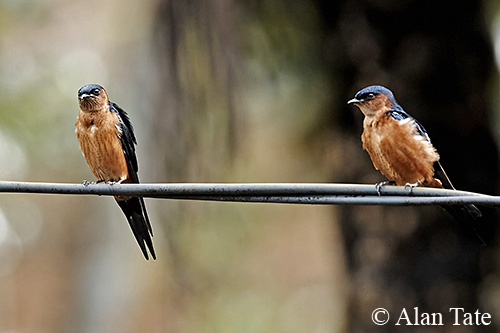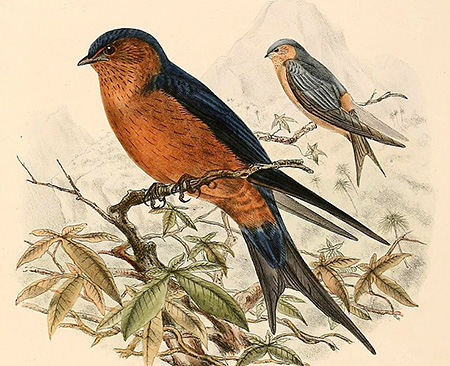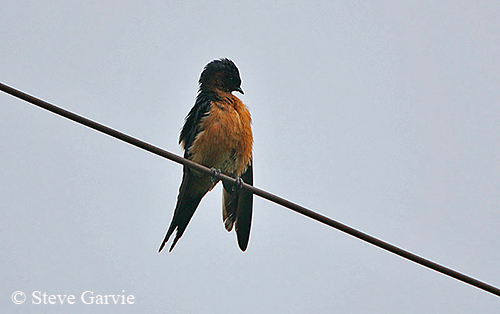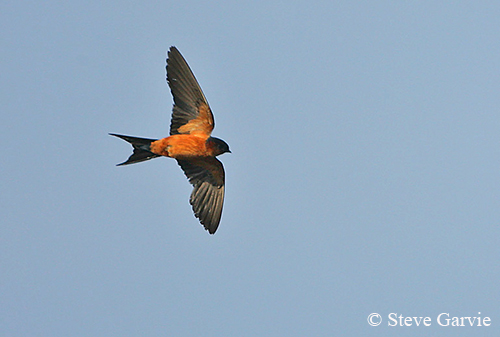
REPRODUCTION OF THIS SPECIES:
The breeding season takes place from March to July, but a second period also occurs from November to January.
The Sri Lanka Swallow breeds usually solitary, although it may sometimes form loose groups of a few pairs.
Both mates maintain a strong pair-bond. Following the displays during which the male circles the female white calling and the copulation, both adults build the nest. It is made of mud pellets stuck on the underside of flat roof, bridge, cave and other surfaces, usually 3 metres above the ground.
The nest is an enclosed structure with a long tunnel entrance on one side. The nest chamber is made of feathers and plant fibres. It is placed within the half dome. Both adults collect mud from the ground and mould it to pellets used to build the nest.
The female lays 2-3 pure white eggs and both adults share the incubation. In the family Hirundinidae, this period usually lasts 14-18 days. The young are fed by both parents and continue to use the nest for roosting, even after fully fledged.
The nest is often reused by the adults for other broods.
PROTECTION / THREATS / STATUS:
The Sri Lanka Swallow is a restricted range species, but it is described as generally common and not globally threatened at the moment.
The size of the population is unknown, but the species does not face any immediate threats to its survival. However, continued monitoring is essential to ensure the future of this beautiful swallow.
The Sri Lanka Swallow is currently evaluated as Least Concern.
Fr: Hirondelle de Ceylan
Ang: Sri Lanka Swallow
All: Rostbauch-Rötelschwalbe
Esp: Golondrina de Sri Lanka
Nd: Ceylonzwaluw
Sd: ceylonsvala
Photographers:
Steve Garvie
RAINBIRDER Photo galleries
Alan & Ann Tate
AA Bird Photography
Illustrator:
Richard Bowdler Sharpe (1847-1909)
Origin of the illustration:
A monograph of the Hirundinidae
Text by Nicole Bouglouan
Sources:
HANDBOOK OF THE BIRDS OF THE WORLD Vol 9 - by Josep del Hoyo - Andrew Elliot - David Christie - Lynx Edicions - ISBN: 8487334695
Fatbirder - The World’s Richest Information Resource about Birds for Birders
CREAGUS@Monterey Bay (Don Roberson)
Wikipedia, the free encyclopaedia
Sri Lanka Swallow
Cecropis hyperythra
Passeriformes Order – Hirundinidae Family
INTRODUCTION:
The Sri Lanka Swallow is a resident breeder, endemic to Sri Lanka.
It was formerly a subspecies of the Red-rumped Swallow and was elevated to full species by 2011.
This species can be seen throughout the island, especially at forest edges, paddy fields, grasslands, plantations and gardens. It feeds mainly on insects caught in flight.
During the breeding season, some displays are observed when the male circles around the female while calling. The Sri Lanka Swallow builds an enclosed nest made of mud pellets and some plant materials inside. Such nest is placed to the underside of a horizontal surface in both natural and artificial sites. Both parents share the nesting duties.
The Sri Lanka Swallow is described as common within its restricted range, and the species is not globally threatened at the moment.
DESCRIPTION OF THE BIRD:
Biometrics:
Length: 13-15 cm
The Sri Lanka Swallow has deeply notched forked tail, and a uniform chestnut colour on rump and underparts. This peculiar unstreaked pattern separates the species from other swallow species on the island.

Crown, nape, hindneck, mantle, back, upperwing and tail are uniformly dark glossy blue.
Rump, chin, throat, foreneck, breast, belly, vent and undertail-coverts are deep rufous with faint dark streaks. Underwing and undertail are dark greyish-blue, but they may appear paler depending on the light when the bird is flying.
The bill is black.
The eyes are brown.
The short legs and the feet are pale greyish-blue. The feet have three toes pointing forwards and only one backwards, allowing the bird to perch easily.
Male and female are similar.
The juvenile is duller overall with shorter tail-streamers.
RANGE:
The Sri Lanka Swallow is an endemic breeder in Sri Lanka, and it is well distributed throughout the island up to about 1,500 metres of elevation.
HABITAT:
The Sri Lanka Swallow occurs across various open country areas on the island, from lowlands to foothills.
It usually frequents roadsides, paddy fields, grasslands, hillsides, open fields, plantations and gardens, and occasionally lightly wooded areas.
The species is visible from lowlands to 1,400-1,500 metres of elevation.

CALLS AND SONGS: SOUNDS BY XENO-CANTO
The Sri Lanka Swallow gives a pleasant, muffled “t’lee” and we can also hear a loud, slow, rising “chuweet”. The species also produces a musical whistle rather prolonged “pfweeouu”.
A high-level alarm call is given when predators are close to the nest. The members of a pair or a family often remain in vocal contact.
The Sri Lanka Swallow also utters a loud twitter while shuffling the wings. Other sounds such as bill-snapping are also made by swallows, especially during courtship.
The nestlings make a faint, squeaky call soon after hatching, used for begging food while they still depend on their parents. This call then develops into an adult contact call.
BEHAVIOUR IN THE WILD:
The Sri Lanka Swallow, like closely related species, feeds on flying insects including flies, beetles and termites throughout the year. The birds can be seen alone, in pair or, more often, is scattered group, flying after insects.
They feed high in the air or low over the vegetation. When they chase fast-flying insects close to the ground, they fly swiftly and turn frequently. At higher levels, they glide but their flight becomes fluttering when they are hunting slower, often aggregated prey.
However, the swallows may also sometimes perch to pick prey from the ground or other surfaces. They are diurnal hunters.
At the beginning of the breeding season, the male performs courtship displays. It circles around the female while calling. If the female perches, the males also perches nearby and sings, while displaying its forked tail. The bond is strong between the two mates.
The Sri Lanka Swallow builds an enclosed nest with long tunnel entrance, typically made of mud-pellets. It is placed on the underside of a horizontal surface, about 3 metres above the ground.
Both adults share all the nesting duties.
The swallows need to keep their feathers in good shape. They are regularly observed preening, mainly in the early morning and the late evening, outside the main feeding periods.
Bathing by skimming over the water and briefly hitting the surface is also observed, as well as sun-bathing on ground, wires, roofs or cliffs. Tail and wings are fanned, the feathers are fluffed and the bill is open.

The Sri Lanka Swallow is probably resident on the island. They may form flocks of tens to hundreds of birds after the breeding season, often mixed with Apodidae species (swifts).
The Sri Lanka Swallow is a good flier. While in flight, the bird flutters the wings rapidly before gliding. Then, it flutters its wings again.
The flight is performed with the wings being open and shut at the wrist join. However, as a resident species, the flight of this species is not as fast as the other swallows. The Sri Lanka Swallow usually performs slow flight with frequent gliding and soaring.
